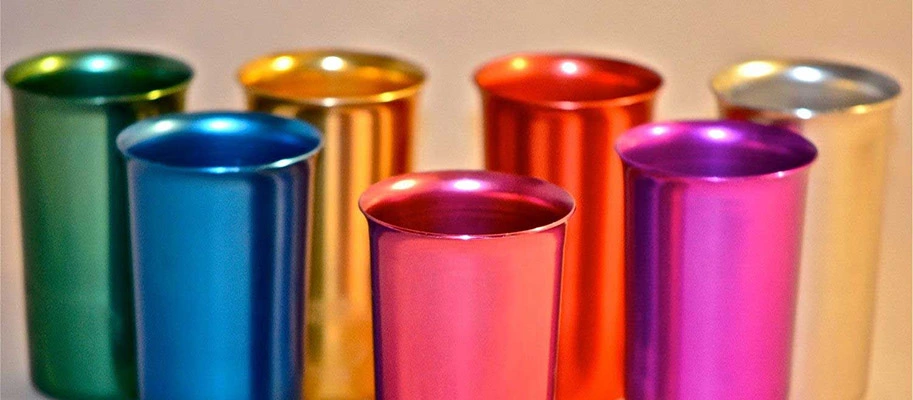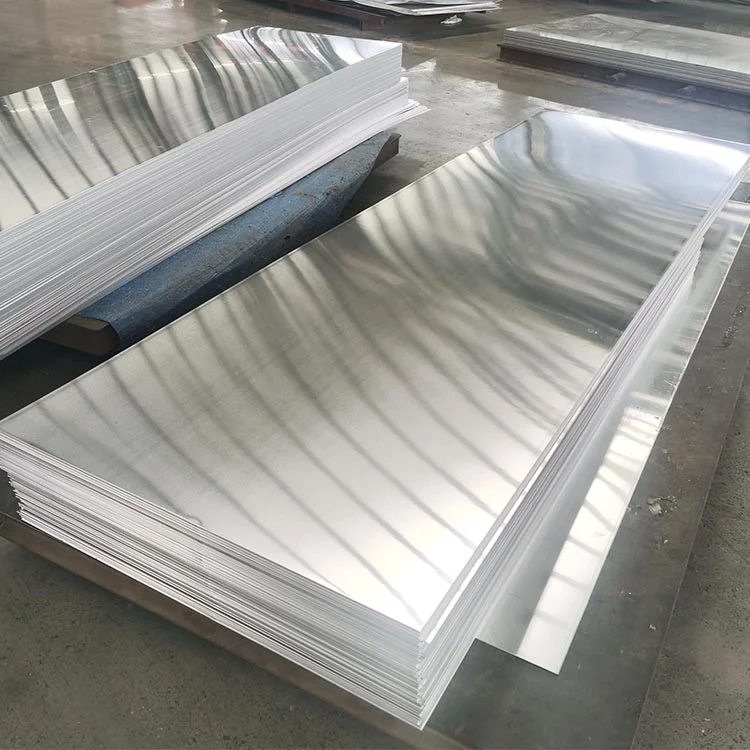Chrome plate aluminum is a surface treatment technology that improves the appearance and performance of aluminum materials by depositing a layer of chromium on their surfaces. The main purpose of chrome plating aluminum is to provide a shiny, mirror-like appearance, making the aluminum material more attractive. At the same time, chromium plating also enhances the corrosion resistance of aluminum and protects aluminum materials from oxidation, corrosion and wear.

Aluminum product manufacturers usually choose some high-quality aluminum plate treatments such as 1000 series aluminum alloy, 3000 series aluminum alloy, 5000 series aluminum alloy, Lega di alluminio serie 6000, etc. for aluminum chromium plating. This makes chromium-plated aluminum widely used in many fields, including auto parts, motorcycle accessories, home decorations, electronic equipment, etc.
Classification of Chrome Plate:
Chrome plating can be divided into two categories according to its use and the characteristics of chromium plate aluminum:
The first type is protective decorative chromium plating, commonly known as decorative chromium: when protective decorative chrome plate, copper, nickel, nickel-iron alloy or copper-tin alloy is usually used as the intermediate layer. The surface of the bright intermediate layer is then plated with 0.2-0.5μm chromium to improve the decorativeness, corrosion resistance and service life of products such as mechanical parts, light industrial products, instruments, medical equipment, etc. Ordinary chromium plating with a plating solution consisting of sulfuric acid and chromic anhydride in protective decorative chromium plating: composite chromium plating with a plating solution; rapid chromium plating with a certain amount of H3BO3 and MgO added to the standard chromium plating electrolyte; chromium plating with SrSO4 and K2SiF6 as catalysts Automatically adjusting chrome plate; as well as micro-cracked chromium, microporous chromium, tetrachromic acid, salt chromium plating; trivalent chromium plating, barrel chrome plating, etc.
One type is functional chromium plating: the main purpose of functional chromium plating is to increase the surface hardness of certain parts, improve wear resistance, or add functions according to the special needs of the product surface, such as using plating to prevent light reflection and improve friction conditions. Functional chrome plating such as hard chrome, milky chrome plating, loose chrome plating and black chrome plating.
Uses of Chrome Plate Aluminum:
- Automotive industry: chrome plate aluminum can be utilized for exterior car adornment, such as wheels, door handles, and roof racks. The shine and corrosion resistance of chrome plate aluminum can improve the appearance and durability of your vehicle.

2. Home decoration: chrome plate aluminum can be used to decorate the home in the form of lights, furniture, door handles, and so on. Chrome-plated aluminum’s sheen and texture can improve the quality and beauty of your home.
3. Electronic items: chrome plate aluminum can be utilized for the shell of electronic products like cell phones and laptop computers. Chrome-plated aluminum’s hardness and abrasion resistance helps safeguard the interior parts of electrical items while also improving their appearance.
4.Cosmetic packaging: chrome plate aluminum can be used for cosmetic packaging, such as lipstick, nail polish, etc. The luster and texture of aluminum chrome plating can enhance the class and appeal of cosmetics.
What Are The Benefits Of Chrome Plating?
- Improve corrosion resistance: Chromium has good corrosion resistance, which can effectively prevent metal products from being damaged by oxidation, corrosion, etc., thereby extending their service life.
- Improve hardness and wear resistance: The chromium layer has a certain hardness and wear resistance, which can effectively improve the wear resistance of metal products, thereby reducing wear and damage. For example, metal products such as bicycles and motorcycles often use chrome plating to improve their wear resistance.
- Improve appearance quality: The chromium layer has good gloss and decorative properties, which can make the surface of metal products smoother and more beautiful, thus improving its appearance quality and added value.
Why Choose Aluminum For Chrome Plate?

Appearance and decoration: Aluminum mental product itself has good appearance properties. Through chromium plate, it can give aluminum material a brighter and mirror-like appearance and improve its decorative properties.
Corrosion resistance: Aluminum is a metal with good corrosion resistance, but it is still prone to oxidation and corrosion under certain environmental conditions, such as humid, acidic or alkaline environments. The addition of chromium plating can effectively protect aluminum materials from oxidation, corrosion and wear and extend their service life.
Light weight: Compared to other metal materials, such as steel, aluminum has a lighter weight. By chromium plating on aluminum materials, the dual advantages of appearance decoration and light weight can be achieved at the same time.
Processing performance: Aluminum material has good process ability and can be used to manufacture products of various shapes and sizes through die casting, forging, extrusion and other methods. Before chroming plate aluminum, aluminum materials can be properly machined and surface treated to meet the needs of different applications.
Can Aluminum Be Chrome Plated?
Generally speaking, high purity aluminum alloy can be chromium plated. This is because the surface of high-purity aluminum has no impurities and can better interact with the chromium plating liquid to form a uniform chromium plating layer. However, if there are contaminants such as oxides, grease, dust, etc. on the aluminum surface, surface treatment is required for better chromium plating. In addition, some aluminum alloys can also be chromium plated, such as:
Aluminum alloy grades: 5052 aluminum, 5083 aluminum, Alluminio 6061, 6063 aluminum, etc.
Reason: These aluminum alloy grades offer good process ability and corrosion resistance, making them suitable for a variety of industrial and structural applications. It contains appropriate amounts of elements such as silicon, magnesium, manganese and zinc, which can provide better chromium plating effects.
Chrome Plate Aluminum Process:
The process of chromium plating on the surface of aluminum plates usually includes the following steps:
Surface treatment: The surface of the aluminum plate alloy needs to be pre-treated to remove oil, oxides and other impurities on the surface to ensure that the chromium liquid can evenly adhere to the surface of the aluminum plate. Commonly used surface treatment methods include mechanical polishing, pickling, alkali cleaning, etc.
Cathodic cleaning: After the surface treatment of the aluminum sheets plates are completed, cathodic cleaning is required to remove residual impurities and oxides on the surface. Cathodic cleaning can be performed using acidic or alkaline cleaning solutions.
Cathodic activation: Cathodic activation is to enhance the conductivity of the surface of the aluminum plate to better absorb chromium ions. Cathodic activation can be performed using acidic or alkaline activation solutions.
Chrome plating: After cathodic activation, the aluminum plates sheets can be immersed in chromium liquid for chromium plating. The chromium liquid contains chromium ions and other additives, which can reduce the chromium ions into chromium metal through electrochemical reaction, thereby forming a uniform chromium plating layer on the surface of the aluminum sheets.
Cleaning and post-processing: After the chromium plating on the surface of the alloy aluminum sheet is completed, cleaning and post-processing are required to remove the residual chromium liquid and other impurities on the surface, and to enhance the corrosion resistance and wear resistance of the chromium plating. Commonly used cleaning and post-processing methods include water washing, pickling, electrolytic polishing, etc.
L'alluminio anodizzato può essere cromato?
In genere, la superficie dell'alluminio elettrificato non è adatta alla cromatura diretta perché lo strato di ossido sulla superficie dell'alluminio elettrificato ostacola il contatto tra la soluzione cromata e il substrato di alluminio, impedendo la cromatura. Aderisce uniformemente alla superficie del substrato di alluminio.

Se è necessario ottenere un effetto di cromatura sulla superficie di alluminio anodizzato, si può pensare di rimuovere prima lo strato di ossido e poi effettuare un trattamento superficiale, ad esempio utilizzando metodi chimici o meccanici per rimuovere lo strato di ossido prima della cromatura. In pratica, per ottenere l'effetto di formazione di uno strato di cromo sulla superficie di alluminio anodizzato si può utilizzare un metodo chiamato "evaporazione". Questo metodo utilizza la tecnologia dell'evaporazione sotto vuoto per far evaporare un sottile film di cromo sulla superficie dell'alluminio anodizzato. Questo sottile film di cromo migliora in una certa misura l'aspetto e la resistenza alla corrosione dell'alluminio anodizzato, ma lo spessore del rivestimento è sottile e non si lega bene al substrato rispetto a un vero rivestimento di cromo.
Quali metalli possono essere cromati?
Metalli che soddisfano le tre caratteristiche di buona conducibilità elettrica, elevata planarità della superficie, assenza di difetti evidenti come protuberanze e fori, non facilmente ossidabili o corrosi. Come nichel, rame, acciaio, leghe di zinco, ecc.
FAQ:
L'alluminio può graffiare il cromo?
Sì, l'alluminio può graffiare il cromo se entra in contatto diretto e viene applicata una forza sufficiente. L'alluminio e il cromo sono entrambi materiali relativamente morbidi, con l'alluminio leggermente più morbido del cromo. Pertanto, se una superficie o un oggetto di alluminio più duro sfrega contro la superficie di cromo, è possibile graffiare o danneggiare il cromo.
Qual è il più costoso tra cromo e alluminio?
Il cromo tende a essere più costoso dell'alluminio a causa del valore aggiunto del processo di cromatura e del costo relativamente elevato del cromo stesso. Le riserve di alluminio sono relativamente abbondanti, il suo costo di produzione è inferiore a quello del cromo e ha un'ampia gamma di utilizzi. Tuttavia, il cromo è spesso aggiunto come rivestimento decorativo o protettivo a una varietà di superfici, tra cui parti di automobili, mobili e accessori, ed è anche essenziale.
Quali sono i pericoli della cromatura?
Ecco alcuni dei principali problemi legati alla cromatura:
Cromo esavalente (Cr(VI)): Il cromo esavalente è una forma altamente tossica di cromo utilizzata nel processo di cromatura e può causare diversi problemi di salute.
Rischi professionali: I lavoratori dell'industria della cromatura, come i galvanici, i lucidatori e i tecnici, sono a rischio di esposizione al cromo esavalente e ad altre sostanze chimiche pericolose utilizzate nel processo.
Impatto ambientale: Lo smaltimento dei rifiuti generati durante il processo di cromatura può avere un impatto significativo sull'ambiente.


